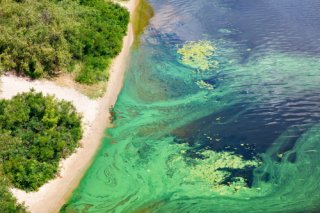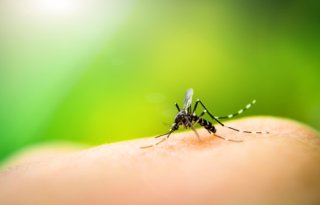Climate Change and the Health of People with Chronic Medical Conditions

Chronic medical conditions are those that last one year or more and either require ongoing medical attention, limit activities/daily living, or both.1 People with chronic medical conditions are more vulnerable than the general population to the health impacts of climate change because:
- Some chronic medical conditions can increase an individual’s risk of illness and death when facing climate change-related impacts, particularly exposure to heat, extreme weather events, water-related illnesses, and poor air quality.2, 3, 4, 5
- People with chronic medical conditions often need consistent medication or medical care. Extreme weather events can disrupt care due to evacuations, transportation system or health infrastructure damages, or power outages.6
- Some medications for chronic conditions can affect the body’s response to heat, putting people at more risk for heat illnesses as the climate warms.7
- Individuals with certain medical conditions can have compromised immune systems, which can make them more prone to extreme reactions related to heat, insect- and tick-related diseases, and water-related illnesses.8, 9
- People with chronic mental illnesses are vulnerable to trauma from extreme weather events, as well as disruptions to support networks and mental health care.10
- Key Threats to the Health of People with Chronic Medical Conditions
- What You Can Do
- Related Resources
- Endnotes
Key Threats to the Health of People with Chronic Medical Conditions
A number of climate-related hazards threaten the health of people with chronic medical conditions. Below are some examples of the potential health impacts of these hazards.
- Water-Related Illnesses
- Respiratory Illnesses
- Heat Illnesses
- Insect- and Tick-Related Diseases
- Mental Health Effects
Water-Related Illnesses

Climate change will impact water resources in many ways. For example, changes in water and air temperatures, heavier and longer rains, flooding, and rising sea levels can introduce disease-carrying organisms into drinking water supplies and recreational waters.14, 15
Drinking or coming in contact with untreated contaminated water can cause gastrointestinal illnesses and other health impacts.16 People with certain chronic medical conditions, such as those with compromised immune systems, can be more at risk of having severe effects from a water-related illness.17
Climate change may increase the likelihood of harmful algal blooms caused by certain types of algae and bacteria.18 Harmful algal blooms can make drinking and recreational water sources unsafe. For example, swimming in waters with a harmful algal bloom can cause respiratory illnesses and eye irritation.19 People with chronic respiratory diseases, specifically asthma, are at increased risk of illness from harmful algal blooms.20
Respiratory Illnesses
Climate change may increase outdoor air pollutants, such as ground-level ozone and particulate matter in dust from droughts and wildfire smoke.22 People with conditions such as hypertension, diabetes, and COPD are particularly vulnerable to adverse effects from exposure to these pollutants.

Climate change can also prolong the allergy season and increase pollen and other outdoor allergens. Data show the ragweed pollen season is already becoming longer in some U.S. locations.23 These allergens can worsen chronic respiratory conditions and contribute to the onset of asthma.24
Indoor contaminants, such as bacteria and mold, could also increase as the climate changes due to more humidity and dampness from frequent heavy rains, storms, and floods.25 Asthmatics and people with compromised immune systems are more vulnerable to indoor air pollutants than the general population.26
Some people with chronic medical conditions may be part of other groups vulnerable to climate change. This can increase their health risks. For instance, low-income groups, people with limited English proficiency, certain immigrant groups, and communities of color have a greater incidence of chronic medical conditions such as heart and kidney disease, diabetes, asthma, and chronic obstructive pulmonary disorder (COPD).12 Black or African American populations have higher rates of asthma, decreased lung function, and heart issues.13 Older adults and children can also have chronic medical conditions.
Heat Illnesses
Heat illnesses can occur when a person is exposed to high temperatures and their body cannot cool down. Increases in average and extreme temperatures and heat waves are expected to lead to more heat illnesses and deaths among vulnerable groups, including older adults.28 Temperature extremes can worsen some chronic medical conditions, such as heart and respiratory disease and diabetes.29 At the same time, some medical conditions, such as obesity and heart disease, increase people’s sensitivity to heat, putting them at greater risk of heat illnesses.30 In addition, some medications (such as some antidepressants, diuretics, and beta-blockers) taken for a chronic illness may increase an individual’s sensitivity to heat by interfering with the body’s ability to regulate temperature, fluids, or electrolytes.31

Insect- and Tick-Related Diseases
Warmer temperatures associated with climate change can also increase mosquito development and biting rates, while increased rainfall can create more breeding sites for mosquitos.33
Mosquitoes can transmit diseases, such as West Nile virus. These diseases pose a greater risk to people with compromised immune systems, who may be more likely to experience severe illness.34 Most people do not develop symptoms with West Nile virus. However, some develop serious illness and even die.35
Studies show that climate change has already contributed to an expanded range for ticks.36 This could put more people at risk of contracting Lyme disease. Lyme disease can cause heart problems in some people.37 It can also cause chronic pain and neurological problems if not treated early.38

Mental Health Effects
As of 2022, approximately 59.3 million (more than one in five) U.S. adults live with a mental illness.40 Individuals with these conditions are particularly vulnerable to certain threats associated with climate change.41 For example, some medications used to treat mental illnesses increase a person’s risk for heat-related illness.42
Certain conditions, such as different types of dementia, can affect an individual’s judgment or reactions, increasing the risk of harm during a weather-related disaster.43 People with an existing mental illness are also more at risk for distress and other mental health effects following such an event.44
People with chronic medical conditions and their loved ones or caretakers can take steps to reduce the health impacts of climate change. Consider the following action items:
- Be safe in the heat. Schedule outdoor activities carefully and pace yourself when exercising. Get plenty of rest. Also, be sure to know the signs of heat stress during extreme heat.
- Stay informed about air quality. Use AirNow to check local air pollution levels and make informed choices about outdoor activities and possible health impacts.
- Prevent bites. Control mosquitoes inside and outside your home. Protect yourself before you go outdoors. Use an insect repellent that is right for you. Always check the label before using a product.
- Protect yourself from floodwater. If possible, avoid contact with floodwater. If you do come in contact with floodwater, wash your hands and take care of any wounds.
- Make a plan. Create an emergency preparedness plan for natural disasters and other emergencies. Protect medical records and prepare a two-week supply of medications, food, water, and medical supplies.
- Keep in touch. Check in regularly on friends and loved ones who have chronic medical conditions.
- Practice self-care. Take care of your emotional health during an emergency. Continue treatment plans as possible, and know where to seek emergency help in the event of a disaster.
Related Resources
- Climate and Health Assessment
- Fifth National Climate Assessment
- National Climate Assessment, Chapter 15: Human Health
EPA resources:
Other resources:
Endnotes
1 Centers for Disease Control and Prevention (CDC). (2024). About chronic diseases. Retrieved 7/22/2024.
2 Gamble, J.L., et al. (2016). Ch. 9: Populations of concern. In: The impacts of climate change on human health in the United States: A scientific assessment. U.S. Global Change Research Program, Washington, DC, p. 260.
3 Bell, J.E., et al. (2016). Ch. 4: Impacts of extreme events on human health. In: The impacts of climate change on human health in the United States: A scientific assessment. U.S. Global Change Research Program, Washington, DC, p. 105.
4 Fann, N., et al. (2016). Ch. 3: Air quality impacts. In: The impacts of climate change on human health in the United States: A scientific assessment. U.S. Global Change Research Program, Washington, DC, p. 82.
5 Trtanj, J., et al. (2016). Ch. 6: Climate impacts on water-related illness. The impacts of climate change on human health in the United States: A scientific assessment. U.S. Global Change Research Program, Washington, DC, p. 170.
6 Hayden, M.H. et al. (2023). Ch. 15: Human Health. Fifth National Climate Assessment. U.S. Global Change Research Program, Washington, DC, p. 15-14.
7 Hayden, M.H. et al. (2023). Ch. 15: Human Health. Fifth National Climate Assessment. U.S. Global Change Research Program, Washington, DC, p. 15-6.
8 Beard, C.B., et al. (2016). Ch. 5: Vector-borne diseases. The impacts of climate change on human health in the United States: A scientific assessment. U.S. Global Change Research Program, Washington, DC, p. 142.
9 Trtanj, J., et al. (2016). Ch. 6: Climate impacts on water-related illness. The impacts of climate change on human health in the United States: A scientific assessment. U.S. Global Change Research Program, Washington, DC, p. 159 and p. 170.
10 Dodgen, D., et al. (2016). Ch. 8: Mental health and well-being. In: The impacts of climate change on human health in the United States: A scientific assessment. U.S. Global Change Research Program, Washington, DC, p. 226.
11 Gamble, J.L., et al. (2016). Ch. 9: Populations of concern. In: The impacts of climate change on human health in the United States: A scientific assessment. U.S. Global Change Research Program, Washington, DC, p. 261.
12 Gamble, J.L., et al. (2016). Ch. 9: Populations of concern. In: The impacts of climate change on human health in the United States: A scientific assessment. U.S. Global Change Research Program, Washington, DC, p. 252.
13 Fann, N., et al. (2016). Ch. 3: Air quality impacts. In: The impacts of climate change on human health in the United States: A scientific assessment. U.S. Global Change Research Program, Washington, DC, p. 82.
14 Trtanj, J., et al. (2016). Ch. 6: Climate impacts on water-related illness. In: The impacts of climate change on human health in the United States: A scientific assessment. U.S. Global Change Research Program, Washington, DC, pp. 159-161.
15 Hayden, M.H. et al. (2023). Ch. 15: Human Health. Fifth National Climate Assessment. U.S. Global Change Research Program, Washington, DC, p. 15-9.
16 Trtanj, J., et al. (2016). Ch. 6: Climate impacts on water-related illness. In: The impacts of climate change on human health in the United States: A scientific assessment. U.S. Global Change Research Program, Washington, DC, p. 165.
17 Trtanj, J., et al. (2016). Ch. 6: Climate impacts on water-related illness. In: The impacts of climate change on human health in the United States: A scientific assessment. U.S. Global Change Research Program, p. 170.
18 Payton, E.A. et al. (2023). Ch. 4: Water. Fifth National Climate Assessment. U.S. Global Change Research Program, Washington, DC, p. 4-5.
19 Trtanj, J., et al. (2016). Ch. 6: Climate impacts on water-related illness. In: The impacts of climate change on human health in the United States: A scientific assessment. U.S. Global Change Research Program, Washington, DC, p. 165.
20 Trtanj, J., et al. (2016). Ch. 6: Climate impacts on water-related illness. In: The impacts of climate change on human health in the United States: A scientific assessment. U.S. Global Change Research Program, Washington, DC, p. 165.
21 U.S. Environmental Protection Agency (EPA). (2024). Climate change and harmful algal blooms. Retrieved 11/27/2024.
22 West, J.J. et al. (2023). Ch. 14: Air Quality. Fifth National Climate Assessment. U.S. Global Change Research Program, Washington, DC, p. 14-7.
23 West, J.J. et al. (2023). Ch. 14: Air Quality. Fifth National Climate Assessment. U.S. Global Change Research Program, Washington, DC, p. 14-14.
24 Fann, N., et al. (2016). Ch. 3: Air quality impacts. The impacts of climate change on human health in the United States: A scientific assessment. U.S. Global Change Research Program, Washington, DC, p. 80.
25 Fann, N., et al. (2016). Ch. 3: Air quality impacts. The impacts of climate change on human health in the United States: A scientific assessment. U.S. Global Change Research Program, Washington, DC, p. 81.
26 Fann, N., et al. (2016). Ch. 3: Air quality impacts. The impacts of climate change on human health in the United States: A scientific assessment. U.S. Global Change Research Program, Washington, DC, pp. 80–82.
27 Fann, N., et al. (2016). Ch. 3: Air quality impacts. The impacts of climate change on human health in the United States: A scientific assessment. U.S. Global Change Research Program, Washington, DC, p. 81.
28 Crimmins, A., et al. (2016). Executive summary. In: The impacts of climate change on human health in the United States: A scientific assessment. U.S. Global Change Research Program, Washington, DC, p. 6.
29 Sarofim, M.C., et al. (2016). Ch. 2: Temperature-related death and illness. In: The impacts of climate change on human health in the United States: A scientific assessment. U.S. Global Change Research Program, Washington, DC, p. 64.
30 Balbus, J., et al. (2016). Ch. 1: Introduction: Climate change and human health. In: The impacts of climate change on human health in the United States: A scientific assessment. U.S. Global Change Research Program, Washington, DC, p. 34.
31 Gamble, J.L., et al. (2016). Ch. 9: Populations of concern. In: The impacts of climate change on human health in the United States: A scientific assessment. U.S. Global Change Research Program, Washington, DC, p. 261.
32 Sarofim, M.C., et al. (2016). Ch. 2: Temperature-related death and illness. In: The impacts of climate change on human health in the United States: A scientific assessment. U.S. Global Change Research Program, Washington, DC, p. 55.
33 Beard, C.B., et al. (2016). Ch. 5: Vector-borne diseases. In: The impacts of climate change on human health in the United States: A scientific assessment. U.S. Global Change Research Program, Washington, DC, pp. 141–142.
34 Gamble, J.L., et al. (2016). Ch. 9: Populations of concern. In: The impacts of climate change on human health in the United States: A scientific assessment. U.S. Global Change Research Program, Washington, DC, p. 258.
35 CDC. (2024). About West Nile virus. Retrieved 7/22/2024.
36 Hayden, M.H. et al. (2023). Ch. 15: Human Health. Fifth National Climate Assessment. U.S. Global Change Research Program, Washington, DC, p. 15-8.
37 CDC. (2024). Clinical care and treatment of Lyme carditis. Retrieved 7/22/2024.
38 CDC. (2024). Signs and symptoms of Lyme disease. Retrieved 7/22/2024.
39 CDC. (2024). About West Nile virus. Retrieved 7/22/24.
40 National Institute of Mental Health. (2022). Mental illness. Retrieved 11/01/2024.
41 Hayden, M.H. et al. (2023). Ch. 15: Human Health. Fifth National Climate Assessment. U.S. Global Change Research Program, Washington, DC, p. 15-10.
42 Dodgen, D., et al. (2016). Ch. 8: Mental health and well-being. In: The impacts of climate change on human health in the United States: A scientific assessment. U.S. Global Change Research Program, Washington, DC, p. 226.
43 Gamble, J.L., et al. (2016). Ch. 9: Populations of concern. In: The impacts of climate change on human health in the United States: A scientific assessment. U.S. Global Change Research Program, Washington, DC, p. 261.
44 Dodgen, D., et al. (2016). Ch. 8: Mental health and well-being. In: The impacts of climate change on human health in the United States: A scientific assessment. U.S. Global Change Research Program, Washington, DC, p. 230.
